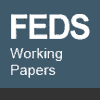
| Finance and Economics Discussion Series |
|---|
 |
The Automatic Stabilizers: Quietly Doing their Thing Darrel S. Cohen and Glenn R. Follette 1999-64 |
Abstract: This paper presents theoretical and empirical analysis of automatic fiscal
stabilizers, such as the
income tax and unemployment insurance benefits. Using the modern theory of
consumption
behavior, we identify several channels--insurance effects, wealth effects and
liquidity constraints-
-through which the optimal reaction of household consumption plans to aggregate
income shocks
is tempered by the automatic fiscal stabilizers. In addition we identify a cash
flow channel for
investment.
The empirical importance of automatic stabilizers is addressed in several
ways. We
estimate elasticities of the various federal taxes with respect to their tax
bases and responses of
certain components of federal spending to changes in the unemployment rate.
Such estimates are
useful for analysts who forecast federal revenues and spending; the estimates
also allow high-
employment or cyclically-adjusted federal tax receipts and expenditures to be
estimated. Using
frequency domain techniques, we confirm that the relationships found in the time
domain are
strong at the business cycle frequencies. Using the FRB/US macro-econometric
model of the
United States economy, the automatic fiscal stabilizers are found to play a
modest role at
damping the short-run effect of aggregate demand shocks on real GDP, reducing
the "multiplier"
by about 10 percent. Very little stabilization is provided in the case of an
aggregate supply
shock.
Home | FEDS | List of 1999 FEDS papers
Accessibility
To comment on this site, please fill out our feedback form.
Last update: January 19, 2000